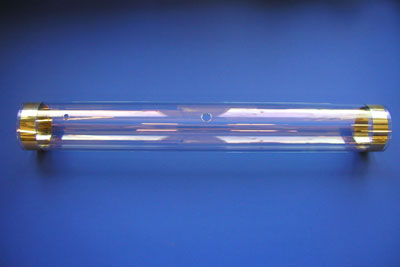| Posted: August 31, 2010 |
Glass magic - a film that changes what glass can do |
|
(Nanowerk News) Fogged or frozen windows are the bane of drivers' lives in winter. Researchers have developed a process that allows them to manufacture not just transparent, but heatable films. These films also prevent condensation, ensuring ice cannot build up on the windscreen overnight – and, once and for all, consigning the ice scraper to the trash can. A prototype of this kind of film can be seen at the glasstec trade fair due to be held in Düsseldorf from September 28 to October 1.
|
 |
| A transparent heatable film made out of indium tin oxide surrounds this glass tube.
|
|
Drivers do not relish the winter: it is cold, driving on icy roads is no fun. Added to which is poor visibility if the windows mist up, and the laborious morning ritual of having to scrape off the ice. Likewise, the winter poses its own problems for anyone with a greenhouse. The more condensation you have inside, the greater the threat to plants if the temperature falls below freezing. While heaters may be a solution in many cases, a better option – especially concering energy costs – would be to ensure the problem does not arise in the first place. And that means preventing condensation on windows. All of which would save a great deal of hassle – and car owners can save the time they once spent scraping off the ice.
|
|
Researchers at the Fraunhofer Institute for Surface Engineering and Thin Films IST in Braunschweig have now solved the problem by developing a process that can be used to manufacture transparent, conductive – and therefore heatable – films. Moreover, their surface films also provide another decisive advantage: the low emitting properties of the outer film ensure the window cools down much more slowly, preventing condensation. The window remains dry and ice-free. Films that up to now have been produced with tin oxide are both mechanically and optically still far from ideal. Cracks may form as a result of excessive temperature loads – a problem encountered during the glass bending process. As a result, tin-oxide films only have limited industrial applications.
|
|
"Our new film is extremely resilient", says Dr. Bernd Szyszka from the Fraunhofer IST. "Temperatures up to 900 degrees Celsius are no problem, and even if you bend it aggressively – the film remains intact." The coating can therefore also be used in large industrial plants where transparent protective heaters are often required to monitor the process chain safely.
|
|
What can the new film do that tin oxide cannot? "Our coating system is based on nanocrystalline indium tin oxide (ITO)", says Szyszka. "This material doesn't just have outstanding optical and electrical properties; it is also mechanically and chemically much more stable than tin oxide."
|
|
While the advantages of the ITO coating have been known for many years, it is only now – thanks to the Fraunhofer engineers – that these kinds of film systems can be manufactured industrially for a much larger range of applications. The researchers are utilizing High Power Impulse Magnetron Sputtering technology, or HIPIMS. With magnetron sputtering, accelerated noble-gas ions shoot atoms from an ITO plate, much like what happens with billiard balls. These atoms are deposited on the required substrate in vacuum.
|
|
"Yet instead of 10 amperes we use 1000 amperes with HIPIMS", explains Szyszka. "We ionize the sputtered material; therefore the film is build up by higher energetic particles and shows superior properties." All of which provide the engineers with a major advantage: depending on the pulse and power conditions during sputtering, the engineers can adjust the texture and morphology of the film so that it subsequently takes on the desired properties during a subsequent tempering process. "We can then bend the film and even coat three-dimensional materials with the technology", says the researcher. The HIPIMS process can also be conducted at room temperature, so that even temperature-sensitive plastics can be coated.
|
|
The Fraunhofer IST researchers will be showcasing a prototype at glasstec (Hall 14, Booth C 41), due to be held in Düsseldorf from September 28 to October 1. An ITO film on a glass tube demonstrates the outstanding properties achieved. Not only is the film easy to heat – without any of the annoying wires commonly found in a rear-heated window – the film boasts an optical transmission ratio of over 80 percent. The coating is also corrosion- and scratch-resistant. It can even provide scratch protection for float glass, a special type of flat glass.
|

